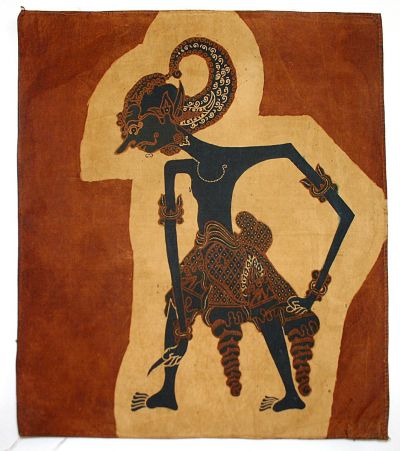
Batik textile with wayang figure (Bima)
| Accession Nr.: | 65.14.1 |
|---|---|
| Type: | textile; puppetry and shadow play; textile arts |
| Date of production: |
19th century
|
| Place of production: |
On a rusty red base, the figure of a wayang kulit shadow puppet becomes visible in a bright frame. He is Bima (Werkudara), the second Pandawa brother, one of the protagonists of the Mahabharata epic. He has an extremely strong sense of justice, and although he is a steadfast warrior, he is too easily rattled.
According to the wayang tradition, it is his hair, clothes, accessories, and the way he holds his hands and head that help identify the character. A distinctive feature is the long, curved thumbnails (kuku pancanaka) worn at the end of the index fingers, which are used as weapons.
The art of batik has developed a carefully elaborated palette of forms and colours that vary from region to region, but there are also motifs reserved exclusively for monarchs. Another form of batik is created by the use of printing blocks ('cap').
Undoubtedly, Java has long been a batik stronghold. The technique consists of first sketching the desired pattern on an uncoloured canvas, then using a special tool called 'canting' to wax the areas to be left uncoloured. The fabric is then dipped into the paint where the wax layer protects the area it covers. The wax is then melted off in hot water, allowing the empty part to be coloured.
According to the wayang tradition, it is his hair, clothes, accessories, and the way he holds his hands and head that help identify the character. A distinctive feature is the long, curved thumbnails (kuku pancanaka) worn at the end of the index fingers, which are used as weapons.
The art of batik has developed a carefully elaborated palette of forms and colours that vary from region to region, but there are also motifs reserved exclusively for monarchs. Another form of batik is created by the use of printing blocks ('cap').
Undoubtedly, Java has long been a batik stronghold. The technique consists of first sketching the desired pattern on an uncoloured canvas, then using a special tool called 'canting' to wax the areas to be left uncoloured. The fabric is then dipped into the paint where the wax layer protects the area it covers. The wax is then melted off in hot water, allowing the empty part to be coloured.